Learn about the enigmatic Girgashites mentioned in the Bible and uncover the secrets hidden within their ancient stories.

Girgashites in the Bible
Have you ever stumbled upon the Girgashites in your biblical journey and wondered who they were? They're mentioned alongside the more familiar Canaanites and Hittites, yet their story often remains shrouded in mystery.
You'll find that understanding their role and significance offers a richer perspective on the ancient narratives. As we explore their historical and cultural context, you'll discover how they fit into the broader story of the Israelites and what archaeological insights suggest about their civilization.
Stick around, and you might uncover some intriguing aspects of biblical history that often go unnoticed.
Key Takeaways
- Girgashites are an ancient group mentioned in the Hebrew Bible, linked to the Near Eastern history.
- Their interactions with Israelites included conflict, cohabitation, and conquest, shaping socio-political landscapes.
- Cultural practices reveal a complex society with rituals, social hierarchy, and unique identity.
- Modern interpretations view Girgashites symbolically, influencing spiritual discourse and personal faith reflection.
Who Were the Girgashites?
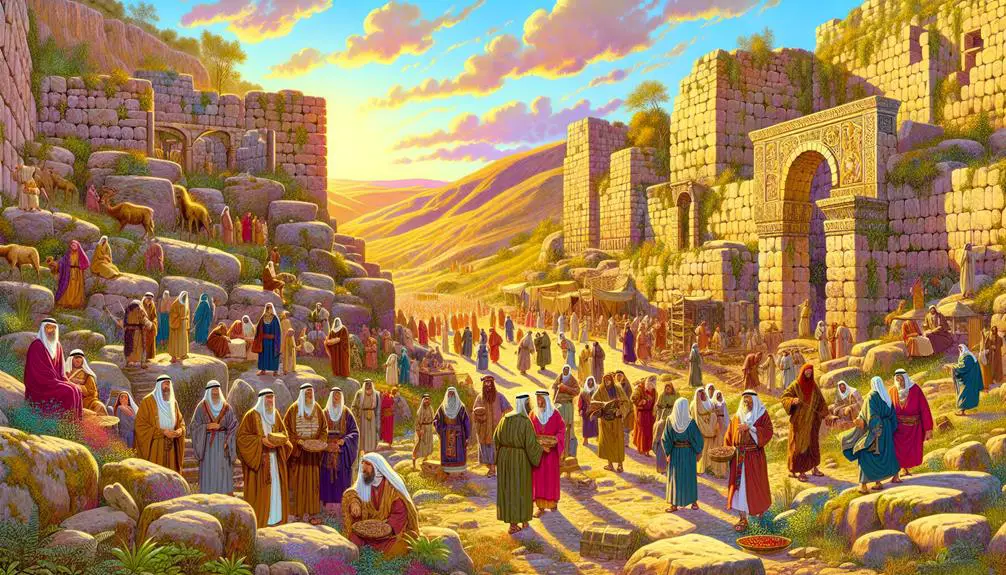
The Girgashites, one of the ancient peoples mentioned in the Hebrew Bible, are often shrouded in mystery due to the scant details provided about their culture, location, and historical significance. You'll find that the Girgashite genealogy, while not extensively documented, offers a fascinating glimpse into their lineage, connecting them to a broader narrative of ancient Near Eastern peoples. Their mention alongside other tribes in various biblical texts suggests they played a role in the complex socio-political landscape of the time, yet their specific contributions and interactions remain largely speculative.
Delving into the Girgashite genealogy, you encounter a web of relationships and affiliations with other ancient groups. This examination not only helps to place the Girgashites within the larger context of Semitic peoples but also highlights the interconnectedness of these groups, suggesting a shared cultural and historical background that has been largely lost to time. The lack of concrete information prompts a reliance on archaeological findings and comparative studies to piece together their story.
Modern parallels draw attention to how contemporary scholars and archaeologists approach the study of such elusive groups. The methods used to trace the Girgashites' lineage and infer their societal structure can be seen in current efforts to understand other ancient civilizations with minimal historical records. This parallel underscores the ongoing challenge in reconstructing the past and the necessity of interdisciplinary approaches to fill in the gaps left by historical and biblical accounts.
Biblical References Explored
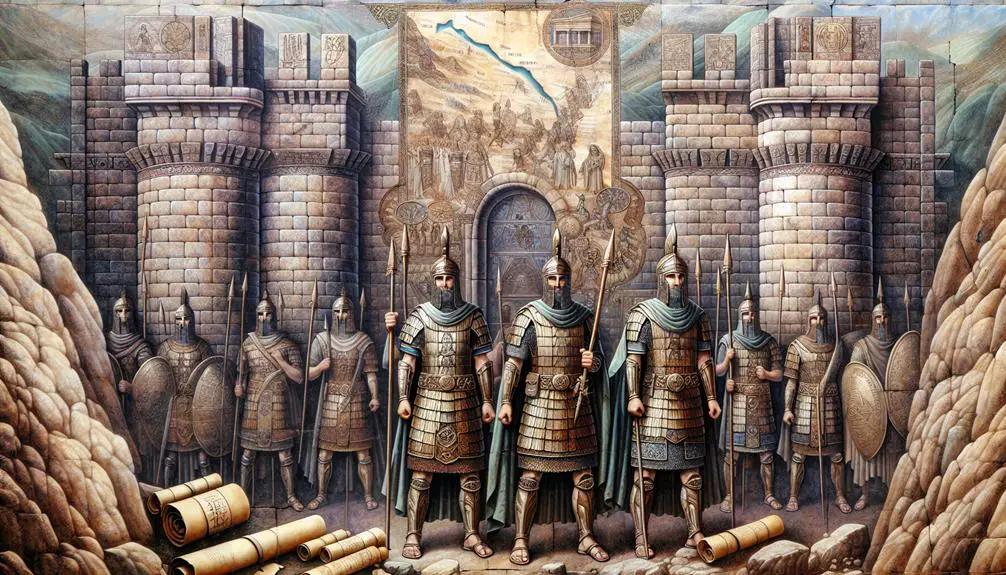
Having explored the genealogical backdrop of the Girgashites, we now turn our attention to scrutinizing the specific biblical passages where they're mentioned, aiming to unearth insights about their role and presence in ancient texts. The Girgashite genealogy interlinks them with other Canaanite tribes, setting a foundation for understanding their narrative within the biblical context. Their mention alongside prominent groups underscores their significance in the ancient Near East.
Here's a closer examination:
- Genesis 10:16 and 1 Chronicles 1:14 – These verses position the Girgashites within the Table of Nations, delineating their lineage from Canaan. This genealogical detail is pivotal, situating them among the peoples whom the Israelites were instructed to dispossess upon entering the Promised Land.
- Genesis 15:21 – God's covenant with Abraham includes a promise that his descendants will inherit the land of various tribes, including the Girgashites. This passage underscores their role as occupiers of territory destined for the Israelites, highlighting the theological and historical importance of Girgashite cities in the narrative of divine promise and fulfillment.
- Deuteronomy 7:1 and Joshua 24:11 – These texts document the command to the Israelites to conquer the land inhabited by the Girgashites among others, emphasizing their presence as a hurdle to the fulfillment of God's promise. The mention of Girgashite cities in these conquest narratives illustrates their tangible presence in the land.
- Nehemiah 9:8 – Reflecting back, this verse acknowledges the fulfillment of God's promise, including the dispossession of the Girgashites. It serves as a retrospective confirmation of the Girgashites' historical and theological role in the narrative of Israel's formation.
This analytical journey through biblical references reveals that the Girgashites, though not frequently mentioned, play a significant role in the unfolding biblical history, primarily as part of the land's ancient inhabitants who were in conflict with the emerging Israelite identity.
Historical and Cultural Context
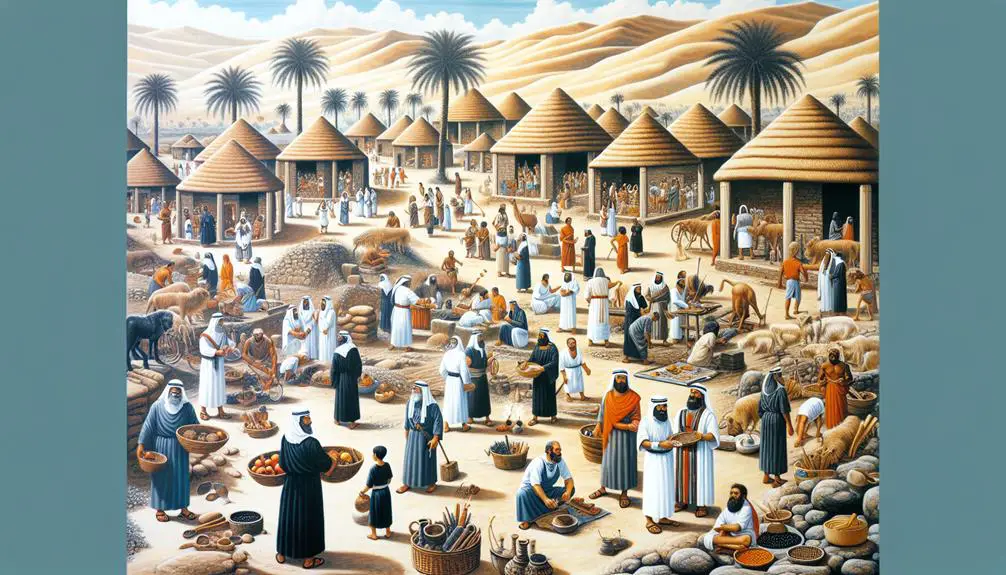
You'll find that understanding the Girgashites' origin sheds light on their place within the broader narrative of ancient Near Eastern history.
Their cultural practices offer insights into their daily lives, social structures, and religious beliefs, which, in turn, illuminate various biblical references to them.
This exploration not only enriches your comprehension of biblical texts but also situates the Girgashites within the complex tapestry of ancient civilizations.
Origin of Girgashites
Often, scholars debate the precise origins of the Girgashites, a group mentioned in biblical texts, situating them within complex socio-historical contexts of the ancient Near East. Your understanding of their emergence is shaped by several factors:
- Geographical speculation: Theories suggest they inhabited areas near the Jordan River, although exact locations remain debated.
- Ancestral lineage: Biblical genealogies imply they descended from Canaan, positioning them within a broader Semitic ancestry.
- Archaeological evidence: Sparse, yet contributes to piecing together their societal structure.
- Linguistic analysis: Offers insights into their connections with neighboring groups.
This analytical approach underscores the multifaceted nature of Girgashite origin, weaving through layers of history, archaeology, and linguistics to reveal a nuanced tapestry of their past.
Cultural Practices
Delving into the cultural practices of the Girgashites reveals a rich tapestry of rituals and social norms deeply rooted in the socio-historical milieu of their time. Their society, characterized by a pronounced social hierarchy, mirrored the complexities of their religious and social beliefs.
The elite class not only governed but also played pivotal roles in religious ceremonies, wielding ritual artifacts with both symbolic and practical utilities. These artifacts, ranging from ceremonial daggers to ornate pottery, were instrumental in the performance of rituals aimed at appeasing deities or marking significant life events.
Such practices underscored the Girgashites' intricate relationship with the divine, where material culture and social stratification converged to create a unique cultural identity. Through these lenses, their societal fabric, steeped in ritualistic traditions, unfolds, offering a glimpse into their worldview.
Biblical References
Exploring the Girgashites' cultural practices further, it's crucial to examine their representation in biblical texts, where historical and cultural contexts provide insights into their societal roles and spiritual beliefs.
- Girgashite Genealogy: Their lineage, as outlined in the Scriptures, offers a foundation for understanding their place within the broader narrative of the ancient Near East.
- Territorial Occupancy: Analysis of biblical geography reveals the strategic significance of Girgashite settlements.
- Cultural Interactions: Their interactions with neighboring tribes and Israelites shed light on the dynamics of ancient diplomacy and conflict.
- Narrative Significance: The role of the Girgashites in biblical stories underscores themes of divine judgment and mercy, illustrating their integral part in the moral and theological tapestry of the text.
This analytical approach highlights their multifaceted role in biblical history.
The Girgashites and the Israelites
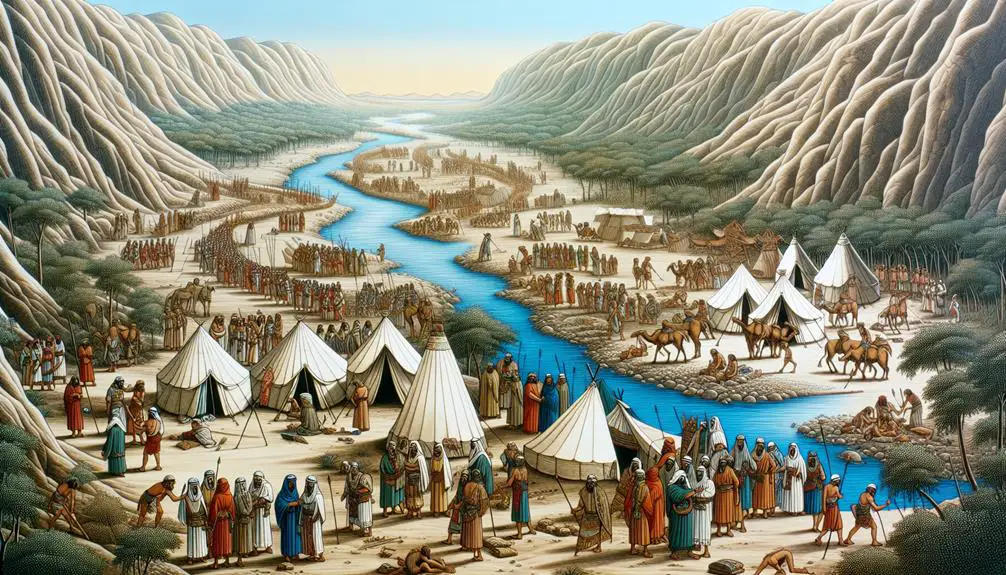
The relationship between the Girgashites and the Israelites, as depicted in biblical texts, illuminates a complex dynamic of conflict, cohabitation, and conquest during the ancient Near Eastern period. Their encounters are marked by military strategies and diplomatic relations, reflecting the broader geopolitical landscape of the time.
The Girgashites, among the nations listed in the conquest narratives of the Israelites, faced formidable military strategies from the Israelite tribes. Their approach wasn't merely about brute strength; it involved calculated moves, espionage, and sometimes, the forging of alliances to secure territorial gains.
Diplomatic relations between the Girgashites and the Israelites also played a pivotal role. At times, these were characterized by treaties aimed at peaceful coexistence within the contested landscapes of Canaan. These agreements were crucial, as they allowed for periods of stability and the blending of cultural practices. However, the underlying tension and the competition for resources often led to the breakdown of these fragile alliances, propelling both groups back into cycles of conflict.
This intricate dance of war and peace underscores the strategic and diplomatic acumen of both the Girgashites and the Israelites. Their interactions weren't merely a series of conquests but a reflection of the nuanced political realities of their time. Understanding this relationship helps you appreciate the complexity of ancient Near Eastern politics and the lasting impact these interactions had on the cultural and historical narrative of the region.
Archaeological Insights
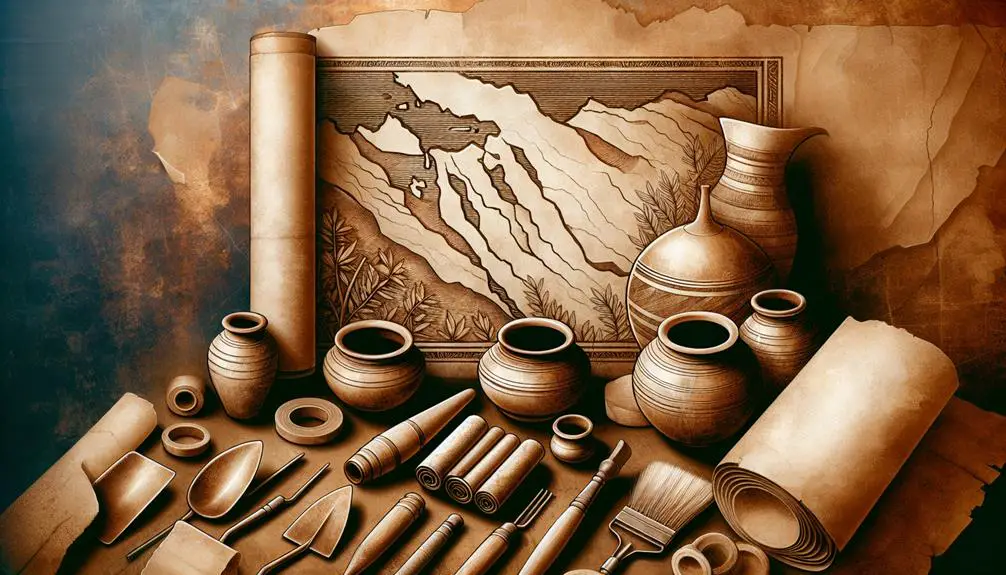
Archaeological discoveries have shed considerable light on the lived realities of the Girgashites, offering a tangible lens through which we can examine their interactions with the Israelites. Sophisticated excavation techniques and meticulous artifact preservation efforts have pieced together a narrative that, while still unfolding, enriches our understanding of this ancient people.
The insights gleaned from these archaeological endeavors can be summarized as follows:
- Excavation Techniques: Modern archaeologists employ a variety of methods, including stratigraphy and radiocarbon dating, to accurately date Girgashite settlements. These techniques provide a chronological framework that aligns with biblical timelines, offering corroborative evidence of the Girgashites' existence and their timeline in history.
- Settlement Patterns: Excavations have uncovered distinct settlement patterns, suggesting a well-organized society with an emphasis on agricultural production. These findings support biblical accounts of the Girgashites residing in specific territories before the Israelite conquest.
- Artifact Preservation: The preservation of pottery, tools, and other everyday items offers insights into the daily life of the Girgashites. These artifacts reveal a culture that was both unique and influenced by neighboring peoples, including the Israelites.
- Cultural Interactions: Archaeological evidence points to periods of both conflict and cooperation between the Girgashites and Israelites. Trade items, shared technologies, and intermingling artistic styles indicate a complex relationship that went beyond mere conquest.
These archaeological insights not only validate historical accounts but also provide a nuanced understanding of the Girgashites, highlighting their role in the broader tapestry of ancient Near Eastern history.
Modern Interpretations and Significance

You may find that contemporary interpretations of the Girgashites extend beyond historical analysis, touching upon symbolic meanings that resonate with today's spiritual and cultural landscapes.
Scholars engage in a cultural impact analysis to ascertain how narratives surrounding the Girgashites have influenced modern identities and societal norms.
Furthermore, theological perspectives explored offer insights into how these ancient peoples continue to inform religious discourse and ethical considerations within various faith communities.
Symbolic Meanings Today
In exploring the symbolic meanings of the Girgashites today, one must delve into how their narrative shapes contemporary interpretations and significance within a modern theological context. The Girgashite metaphors extend beyond their historical presence, offering contemporary relevance in various aspects:
- Resistance to Change: Symbolizing resistance to transformative spiritual forces, mirroring modern reluctance to embrace spiritual or moral evolution.
- Materialism: Reflecting the modern preoccupation with material wealth over spiritual values, paralleling Girgashite tendencies.
- Lost Identity: Representing communities or individuals who've lost their spiritual compass, akin to the Girgashites' historical obscurity.
- Cultural Assimilation: Illustrating the challenges of maintaining faith and identity amidst dominant cultures, echoing the Girgashites' eventual assimilation or disappearance.
These interpretations offer a nuanced lens through which to view contemporary spiritual and moral dilemmas, drawing from ancient narratives to address modern questions.
Cultural Impact Analysis
Examining the Girgashites' portrayal in biblical texts reveals their profound influence on contemporary spiritual discourse, shaping our understanding of moral and spiritual challenges in today's society.
Aspect |
Impact on Modern Interpretations |
Significance |
|---|---|---|
Girgashite Artistry |
Influences modern religious art |
Highlights the role of creativity in worship |
Diplomatic Relations |
Offers insights into biblical diplomacy |
Teaches modern society about conflict resolution |
Spiritual Challenges |
Encourages reflection on personal faith |
Provides lessons on overcoming obstacles |
Moral Lessons |
Shapes contemporary ethical debates |
Promotes understanding of ancient wisdom |
Cultural Narratives |
Enhances the appreciation of biblical heritage |
Bridges past and present cultural dialogues |
This analysis shows how the Girgashites' narrative continues to resonate, influencing both the spiritual and cultural dimensions of modern life.
Theological Perspectives Explored
Delving into theological perspectives offers a nuanced understanding of how Girgashites' portrayals shape modern spiritual interpretations and their significance in contemporary theological discourse.
- Divine Judgment: Their narrative underscores the concept of divine judgment, highlighting how actions align or diverge from divine commands. This aspect encourages a reflection on accountability and the consequences of moral choices.
- Ethical Considerations: The Girgashites' story provokes discussions on ethical considerations within a theological framework, urging believers to contemplate the complexities of righteousness and sin.
- Covenant Relationship: It serves as a reminder of the covenant relationship between the divine and humanity, emphasizing the importance of faithfulness and commitment.
- Interpretive Challenges: Their account presents interpretive challenges, pushing scholars and believers alike to consider the depth and breadth of biblical texts in understanding divine principles and human behavior.
Frequently Asked Questions
How Do Contemporary Religious Communities View the Girgashites Today, and Do They Have Any Symbolic or Moral Lessons Attributed to Them?
You're exploring how contemporary religious groups perceive the Girgashites.
Focusing on modern interpretations of Girgashite rituals, these communities often view them through a lens of symbolic or moral teachings.
Drawing parallels between ancient narratives and today's ethical dilemmas, while specifics vary, the general consensus leans towards seeing their stories as cautionary tales.
Emphasizing the importance of faithfulness and moral integrity, this approach highlights the timeless nature of such lessons, making ancient stories relevant today.
Are There Any Significant Differences in How the Girgashites Are Portrayed or Referenced in Other Religious Texts Outside of the Bible, Such as the Quran or the Texts of Other Abrahamic Faiths?
You're exploring how different texts portray the Girgashites, stepping beyond the Bible. Interestingly, there's scant Quranic mention or archaeological evidence directly referencing them in other Abrahamic faiths. This lack of mention sparks curiosity—why are they prominent in one ancient text but not others?
Analyzing this absence offers a fascinating study in religious narrative and historical record, challenging scholars to piece together the puzzle of ancient peoples and their stories.
Can Linguistic Studies Provide Insights Into the Girgashites' Language, and Has There Been Any Attempt to Reconstruct It or Identify Its Influence on Modern Languages?
Linguistic studies can indeed shed light on the Girgashites' language, potentially revealing its nuances through the analysis of Girgashite pottery inscriptions or related artifacts. There's an ongoing effort to reconstruct it, aiming to trace its impact on contemporary languages.
Researchers are also looking into genetic markers that might link modern populations to the Girgashites, offering a unique insight into how ancient languages evolve and influence today's linguistic landscape.
How Have Artistic Representations of the Girgashites in Literature, Art, and Media Evolved Over Time, and What Are Some Notable Examples?
You've seen Girgashite pottery evolve like a river, flowing from ancient to modern interpretations. Initially depicted in literature and art with a veil of mystery, these representations have become vibrant, shedding light on their culture.
Notable examples include detailed pottery in museums, showcasing intricate designs once lost to time. Modern media has also embraced them, weaving their story into historical narratives, enriching our understanding with every brushstroke and word.
Is There Any Evidence or Scholarly Hypothesis Regarding the Fate of the Girgashites After Their Encounters With the Israelites, Such as Assimilation Into Other Cultures or Migration to New Territories?
You're diving into the question of what happened to a certain ancient group post-conflict.
Archaeological findings and genetic research offer clues but no definitive answers. Scholars hypothesize they might've assimilated into neighboring cultures or migrated to new territories.
This analysis, rooted in detailed, scholarly inquiry, suggests their fate remains partly speculative, guided by the scant evidence and scholarly interpretations available.
It's a complex puzzle, piecing together their story from fragments left behind.
Conclusion
In the tapestry of biblical history, the Girgashites, though shadows among brighter threads, play a crucial role in the unfolding narrative between the divine and the earthly.
Piecing together archaeological puzzles and scriptural whispers, we've traced their silhouette in the sands of time, revealing a people entwined with Israel's destiny.
This exploration, rich in detail and analysis, illuminates the Girgashites' significance, not as mere footnotes, but as integral actors on the stage of sacred history, challenging us to consider the depth of our historical understanding.



Sign up